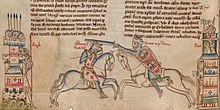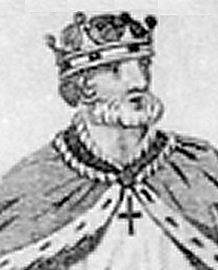Edmund Ironside: Difference between revisions
mNo edit summary |
m →In popular culture: Deleted duplicate sentence. |
||
| Line 54: | Line 54: | ||
==In popular culture== |
==In popular culture== |
||
* Edmund is played by John Horn in the 1970 television movie ''[[The Ceremony of Innocence (film)|The Ceremony of Innocence]]''. He is one of the main characters in [[Justin Hill]]'s novel [[Shieldwall]] (2011), first in the Conquest Trilogy. |
* Edmund is played by John Horn in the 1970 television movie ''[[The Ceremony of Innocence (film)|The Ceremony of Innocence]]''. He is one of the main characters in [[Justin Hill]]'s novel [[Shieldwall]] (2011), first in the Conquest Trilogy. |
||
* Edmund Ironside is a major character in [[Justin Hill]]'s historical novel, ''Shieldwall'', pub. 2011. |
|||
==See also== |
==See also== |
||
Revision as of 04:39, 4 October 2011
| Edmund Ironside | |
|---|---|
 Matthew Paris's (early 13th-century) impression of the Battle of Assandun, depicting Edmund Ironside (left) and Cnut (right) | |
| King of England | |
| Reign | 23 April 1016 – 30 November 1016 |
| Predecessor | Æthelred the Unready |
| Successor | Cnut the Great |
| Born | 989 Wessex, England |
| Died | 30 November 1016 (aged 27) Oxford or London, England |
| Burial | |
| Consort | Ealdgyth |
| Issue | Edward the Exile Edmund |
| House | House of Wessex |
| Father | Æthelred the Unready |
| Mother | Ælfgifu of York |
Edmund Ironside or Edmund II (Template:Lang-ang) (c. 988/993 – 30 November 1016) was king of England from 23 April to 30 November 1016. His cognomen "Ironside" is not recorded until 1057, but may have been contemporary. According to the Anglo-Saxon Chronicle, it was given to him "because of his valour" in resisting the Danish invasion led by Cnut the Great.[1] He fought five battles against the Danes, ending in defeat against Cnut on 18 October at the Battle of Assandun, after which they agreed to divide the kingdom, Edmund taking Wessex and Cnut the rest of the country. Edmund died shortly afterwards on 30 November, and Cnut became the king of all England.
Family
Edmund was a signatory to charters from 993. He was the third of the six sons of King Æthelred the Unready and his first wife, Ælfgifu, who was probably the daughter of Earl Thored of Northumbria. His elder brothers were Æthelstan and Egbert (died c. 1005), and younger ones, Eadred, Eadwig and Edgar.[1] His mother died around 1000,[2] after which his father remarried, this time to Emma of Normandy, who had two sons, Edward the Confessor and Alfred.
Early life
Æthelstan probably did not approve of the increasing influence of ealdorman Eadric Streona from 1007, and he seems to have formed a friendship with Sigeferth and Morcar, two of the leading thegns of the Five Boroughs of the East Midlands.[3] Æthelstan and Edmund were close, and they probably felt threatened by Emma's ambitions for her sons.[4] The Life of Edward the Confessor, written fifty years later, claimed that when Emma was pregnant with him, all Englishmen promised that if the child was a boy they would accept him as king.[1]
When Sweyn Forkbeard seized the throne at the end of 1013 and Æthelred fled to France, the brothers do not appear to have followed him, but stayed in England. Æthelstan died in June 1014 and left his brother estates and a sword which had belonged to king Offa of Mercia.[1] His will also reflected the close relationship between the brothers and the nobility of the east midlands.[5]
Struggle for power
Sweyn died in February 1014, and the Five Boroughs accepted his son Cnut, who married a kinswoman of Sigeferth and Morcar, as king. However, Æthelred returned to England and launched a surprise attack which defeated the Vikings and forced Cnut to flee England. In 1015 Sigeferth and Morcar came to an assembly in Oxford, probably hoping for a royal pardon, but they were murdered by Eadric Streona. King Æthelred then ordered that Sigeferth's widow, Ealdgyth, be seized and brought to Malmesbury Abbey, but Edmund seized and married her in defiance of his father, probably to consolidate his power base in the east midlands.[6] He then received the submission of the people of the Five Boroughs. At the same time, Cnut launched a new invasion of England. In late 1015 Edmund raised an army, possibly assisted by his wife's and mother's links with the midlands and the north, but the Mercians under Eadric Streona joined the West Saxons in submitting to Cnut. In early 1016 the army assembled by Edmund dispersed when Æthelred did not appear to lead it, probably due to illness. Edmund then raised a new army and in conjunction with Earl Uhtred of Northumbria ravaged Eadric Streona's Mercian territories, but when Cnut occupied Northumbria Uhtred submitted to him, only to be killed by Cnut. Edmund went to London.[1]
King of England

Æthelred died on 23 April 1016, and the citizens and councillors in London chose Edmund as king and probably crowned him. He then mounted a last-ditch effort to revive the defence of England. While the Danes laid siege to London, Edmund headed for Wessex, where the people submitted to him and he gathered an army. He fought inconclusive battles against the Danes and their English supporters at Penselwood in Somerset and Sherston in Wiltshire. He then raised the siege of London and defeated the Danes near Brentford. They renewed the siege while Edmund went to Wessex to raise further troops, returning to again relieve London, defeat the Danes at Otford, and pursue Cnut into Kent. Eadric Streona now went over to Edmund, but at the decisive Battle of Assandun on 18 October, Eadric and his men fled and Cnut decisively defeated Edmund. There may have been one further battle in the Forest of Dean, after which the two kings negotiated a peace dividing the country between them. Edmund received Wessex while Cnut took Mercia and probably Northumbria.[1]
Death
Shortly afterwards, on 30 November 1016, King Edmund died, probably in London. Cnut was now able to seize control as king of England. Edmund was buried at Glastonbury Abbey in Somerset. His burial site is now lost. During the Dissolution of the Monasteries, any remains of a monument or crypt were destroyed. The location of his body is unknown.
Heirs
Edmund had two children by Ealdgyth, Edward the Exile and Edmund. According to John of Worcester, Cnut sent them to the king of Sweden to be murdered, but the king instead sent them to Hungary, where Edmund died but Edward prospered. He returned to England in 1057 only to die within days of his arrival.[7]
Reputation
In the view of M. K. Lawson, the intensity of Edmund's struggle against the Danes in 1016 is only matched by Alfred the Great's in 871, and contrasts with Æthelred's failure. Edmund's success in raising one army after another suggests that there was little wrong with the organs of government under competent leadership. He was "probably a highly determined, skilled and indeed inspiring leader of men". Cnut visited his tomb on the anniversary of his death and laid a cloak decorated with peacocks on it to assist in his salvation, peacocks symbolising resurrection.[1]
Shakespearean play?

Edmund Ironside is the name of an anonymous play in the Shakespeare Apocrypha, which has been attributed to Shakespeare on stylistic grounds.[8] Plays in the Shakespeare Apocrypha are not generally accepted as Shakespearean.[9]
In popular culture
- Edmund is played by John Horn in the 1970 television movie The Ceremony of Innocence. He is one of the main characters in Justin Hill's novel Shieldwall (2011), first in the Conquest Trilogy.
See also
Sources
- Anglo-Saxon Chronicle
- Clemoes, Peter. The Anglo-Saxons: Studies Presented to Bruce Dickins, 1959
- The History Channel - England history to 1485
References
- ^ a b c d e f g M. K. Lawson, Edmund II, Oxford Online DNB, 2004
- ^ Simon Keynes, Æthelred the Unready, Oxford Online DNB, 2009
- ^ Simon Keynes, Æthelstan Ætheling, Oxford Online DNB, 2004
- ^ Ryan Lavelle, Aethelred II: King of the English, The History Press, 2008, pp. 172-173
- ^ Lavelle, op. cit., p. 172
- ^ Lavelle, op. cit., pp. 169-172
- ^ M. K. Lawson, Edward Ætheling, Oxford Online DNB, 2004
- ^ Eric Sams. (1986). Shakespeare's "Edmund Ironside": The Lost Play. Wildwood Ho. ISBN 0-7045-0547-9
- ^ Two Tough Nuts to Crack: Did Shakespeare Write the Shakespeare Portions of Sir Thomas More and Edward III? By Ward E. Y. Elliott and Robert J. Valenza, Claremont McKenna College.
